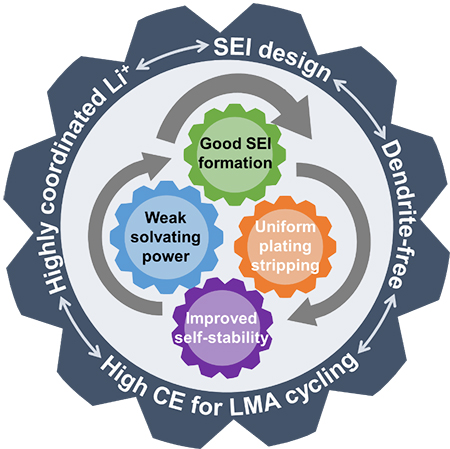Lithium metal is an ideal anode for high-energy-density rechargeable batteries due to its lowest electrochemical potential and high theoretical capacity.
However, the cycling of lithium metal anode (LMA) is limited by the uneven Li plating-stripping and unstable solid electrolyte interphase (SEI).
Recently, a research group led by Prof. CHEN Jian from the Dalian Institute of Chemical Physics (DICP) of the Chinese Academy of Sciences (CAS) developed a dual-strategy with Li-ion solvation and SEI regulation to stabilize lithium metal anode.
This study was published in Energy Storage Materials on Oct. 8.

Dual strategy for improving LMA Coulombic efficiency (Image by ZHU Shengdong)
The researchers used 1,3-dioxolane (DOL) and 1,2-dimethoxyethane (DME) as the solvent, separately blending with fluorinated ether (TTE), to investigate the effect of the solvents for their solvation and electrochemistry in localized high concentration electrolytes (LHCEs).
They found that the weakly solvating capability of DOL weakened the Li-ion interaction with solvents but improved the coordination capability with anions. Hence, DOL-TTE formed a unique solvation structure that differed from DME-TTE blends.
A small amount of TTE could dramatically reshape the coordination structure of the Li-ion in DOL while it could not work in DME. With increasing TTE additions in DOL-TTE blends, ionic aggregates became the dominant solvating configuration, facilitating more anion-derived SEI and dendrites-free morphology.
Moreover, the highly coordinated Li+ solvation of DOL-TTE (1:2) electrolyte could limit the dissolution and loss of LiPSs in Li-SPAN cells, obtaining a high Coulombic efficiency of 99.77% and capacity retention of 92% after 100 cycles.
"This work revealed the solvent effect for positively participating in Li-ion primary solvation sheath and constructing SEI, providing a new possibility for developing LMA electrolytes," said Prof. CHEN.
This work was supported by Strategy Priority Research Program of CAS, R&D Projects in Key Areas of Guangdong Province, Science and Technology Innovation Foundation of Dalian, and Defense Industrial Technology Development Program. (Text by ZHU Shengdong)